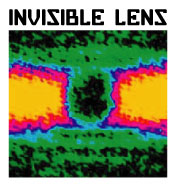A research team at Maryland's A. James Clark School of Engineering has used plasmon technology to create the world's first invisibility cloak for visible light. The engineers have applied the same technology to build a revolutionary superlens microscope that allows scientists to see details of previously undetectable nanoscale objects.
Generally speaking, when we see an object, we see the visible light that strikes the object and is reflected. The Clark School team's invisibility cloak refracts (or bends) the light that strikes it, so that the light moves around and past the cloak, reflecting nothing, leaving the cloak and its contents "invisible."
The invisibility cloak device is created in a thin transparent acrylic plastic layer on a gold film. The plastic and gold each have different refractive properties. The structured plastic on gold in different areas of the cloak creates "negative refraction" effects, which bend plasmons—electron waves generated when light strikes a metallic surface under precise circumstances—around the cloaked region.
This manipulation causes the plasmon waves to appear to have moved in a straight line. In reality they have been guided around the cloak much as water in a stream flows around a rock, and released on the other side, concealing the cloak and the object inside from visible light.
The team also has used plasmonics to develop superlens microscopy technology, which can be integrated into a conventional optical microscope to view nanoscale details of objects that were previously undetectable.
The superlens microscope will be able to image living cells, viruses, proteins, DNA molecules, and other samples, operating much like a point-and-shoot camera. This new technology could revolutionize the capability to view nanoscale objects at a crucial stage of their development. The team believes they can improve the resolution of their microscope images down to about 10 nanometers—one ten thousandth of the width of a human hair.
A large reason for the success of the group's innovations in both invisibility and microscopy is that surface plasmons have very short wave lengths, and can therefore move data around using much smaller-scale guiding structures than in existing devices. These small, rapid waves are generated at optical frequencies, and can transport large amounts of data. The group also has made use of the unique properties of metamaterials, artificially structured composites that help control electromagnetic waves in unusual ways using plasmonic phenomena.
The team's research has been funded by the National Science Foundation and Clark School Corporate Partner BAE Systems.

